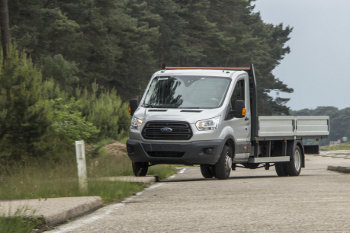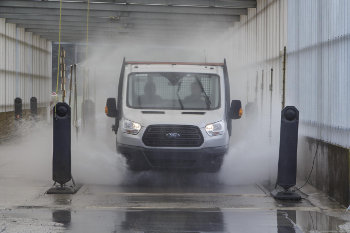
Testing the new Ford Transit off road — all in a day’s work for the average builder!
Like its small sibling, the Transit Custom, Ford has ensured that the all-new Transit will survive 10 years of the toughest treatment by using an especially punishing accelerated ageing process as part of its development.
Durability tests included the equivalent of driving 11 million kilometres – or 275 round-the-world trips – at state-of-the-art proving grounds and in extreme conditions across the globe where temperatures ranged from +40 to -40 deg C.
“I don’t think many customers would believe what this vehicle has been through,” said David Gregory, Transit chief programme engineer, Ford of Europe. “We inflict the worst possible treatment that a van could endure, and we’re only satisfied when our new vehicle comes through with flying colours – just as the Transit has done.”
As the first Transit to be sold in both Europe and North America, the all-new model was subjected to this testing both at Ford’s facilities in Lommel, Belgium, and in Romeo, Michigan.
At Lommel, the all-new Transit, including van, chassis cab and minibus versions, was put through more than 30 punishing vehicle tests. These included the trailer tow general durability test, conducted at maximum weight with a fully loaded trailer and being driven at top speed non-stop for two months, pounding over rough gravel roads, and through salt- and mud-baths. The prototypes also were tested for corrosion resistance in high-humidity chambers for 12 weeks and put through non-stop figure-of-eight manoeuvres for one month.

Couriers are forced to do this around 100 times per day — but not usually at 37mph!
Engineers have driven the all-new Transit more than 5,000 times over an extreme course of potholes and bumps, and conducted a strength test by driving it at 60 km/h (37 mph) into a 14 cm high kerb.
Ford also tested the Transit prototypes from the Austrian Alps to Death Valley: in Europe, North America, Africa and Asia.
Vehicles faced the 40 deg C heat of Arizona, Dubai and South Africa, the bitter -40 deg C cold in Finland (where it won the annual Arctic Van Test) and Canada, as well as challenging journeys through Europe, the Middle East, Russia, Turkey and the U.S.
Prior to launch, the new model covered more than 300,000 miles of tough real-world use with high-mileage Transit customers. In the test labs, the all-new Transit’s 2.2-litre Duratorq diesel engine was subjected to 46 days of continuous high-load urban driving on specialised rigs, as part of tens of thousands of hours of engine testing.
Component test rigs were used to simulate real-world punishment, replicating the full 10-year vehicle lifecycle in just 30 days.

There’s nothing like a salt bath to keep your bodywork in good condition
Ford has made more than 100 significant improvements to the Transit as a direct result of its testing regime including the redesign of the side rail on jumbo van models, and strengthening of the rear cross-member on chassis cabs.
“Pushing the van to the limit and beyond helps us to deliver a stronger, more robust product. This translates directly into every-day reliability for the customer, however tough their working environment,” Gregory added.
The all-new two-tonne Transit is the flagship of the completely redesigned and expanded Ford Transit range, and is now on sale in the UK and across Europe alongside the Transit Custom, Transit Connect and Transit Courier models.
Ford’s made a video showing some of the highlights of the testing, take a look below to see the tests as they happened:
